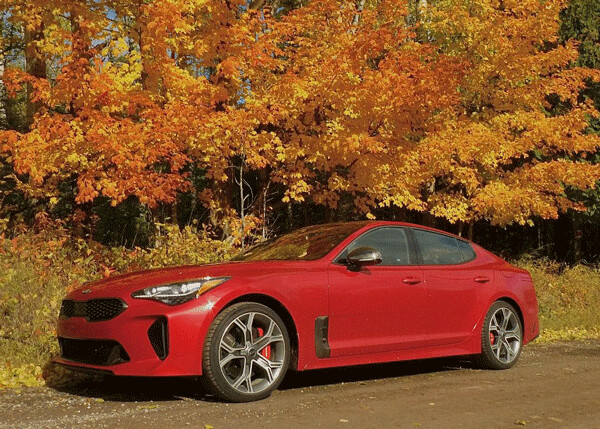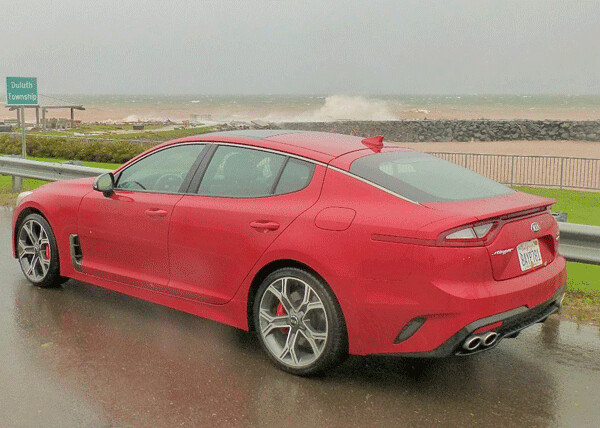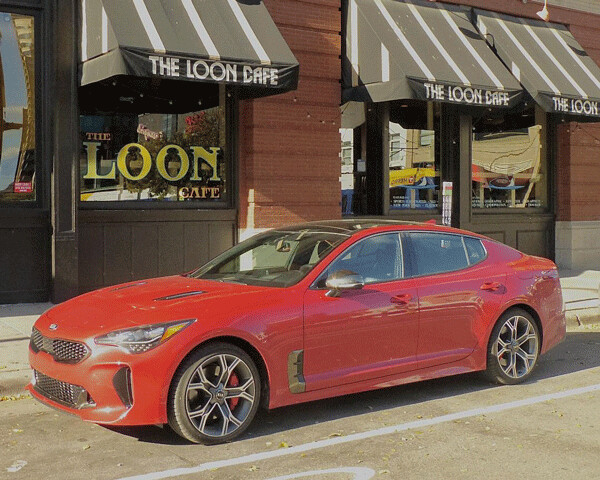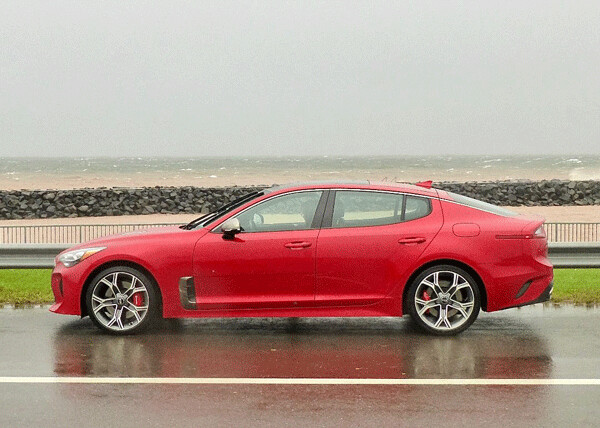Stinger gives Kia a new buzz in performance sedans


The legendary “Gales of November” came in early October this year, and even Gordon Lightfoot would have been fascinated to learn that a Lake Superior freighter radioed in that he had measured the wind gusting to 85 miles per hour. That, the weather guy said, was worthy of a Category 3 hurricane - except everybody knows we don’t have hurricanes on Lake Superior, just gales.
That weather front kept up long enough that I was able to get parts of two auto test drives during the windy stretch. The first had been the feisty little Hyundai Kona compact SUV. The other one was another vehicle I’d been waiting for since a year ago - the Kia Stinger. This one was painted “Hichroma red,” which was a stunning dark red metallic.
It always impresses me how sophisticated car observers are in Duluth, Minnesota. As I was leaving a major store, a fellow yelled over to me: “Where did you get that car? You don’t see those cars around here.” He was right. I hadn’t considered it, but this was one of very few Stingers to hit the pavement in Duluth, and this fellow appreciated it. Others just said, “Nice car!”
Kia is the adopted step-brother of Hyundai, in South Korea, but the folks at Kia have pretty much gone their own way, gleefully accepting Hyundai’s financial solvency and its rather incredible rise to world-class elite status in technology. Kia was getting a serviceable spinoff of whatever Hyundai was getting, but they’ve purposely separated themselves nowadays. They still have sister ships, like the Kia Sportage reflecting the Hyundai Tucson, but there are renegade vehicles like the Kia Soul, and Sedona minivan, for which Hyundai has no versions.


Kia also made a luxury sedan, called the Cadenza, and an upscale larger luxury sedan called the K900. But the Stinger is the marque model for Kia - a true sophisticated sports-luxury sedan. A fellow auto writer I know recently wrote about Kia’s neat little compact, the Forte, and he went overboard suggesting in looks and demeanor the Forte was like a scaled-down Stinger, and had the audacity to conclude that if you could attach Stinger emblems, your neighbors would think you had bought a Stinger. No, they wouldn’t. Because there isn’t any comparison, even in looks. And certainly not in demeanor. The Forte is a neat little compact, but you wouldn’t compare a Cirrus to an F-16, and don’t bore us with the attempt.
Kia didn’t miss any available pieces from the Hyundai-Kia parts bin. Anything that would add sportiness, or pizazz, or all-out athletic disposition was fastened onto the Stinger’s ample frame, and the car is the closest thing ever out of Korea that goes right past Japan’s sportiest sedans, soars over the U.S. attempts, and challenges the best vehicles made in Stuttgart, or Munich, or Ingolstadt.
This is not an attempt to belittle anything with a Mercedes, BMW or Audi, and if you buy one of those you will always love it and admire its performance, but you’ll also have to cope with price tags that are somewhere over $75,000. The Kia Stinger has a sticker of $51,400, and with all the options added on - which is to say freight - the bottom line is $52,300.
For that you embarrass my Forte-loving associate and his spunky little 2.0 turbo for $25,000 with a 3.3-liter V6 with direct injection and dual turbochargers that produce 365 horsepower and 376 foot-pounds of torque, operating through all-wheel drive, and guided by a smooth and seamless 8-speed dual-clutch automatic. It also has torque-vectoring to make you think you’re a better driver than you really are by coaxing the car to trace curves properly even if the driver is less capable.
The test car I got from the press fleet was a 2018 model, which is when the car was finally introduced after making virtually a nationwide tour of car shows and special events.
The Stinger indeed has a special sting to its performance, with 0-60 times in the sub-5-second range, and it stops just as well, with large, red Brembo brakes on all four corners. Inside the cockpit, you sit in a firmly supportive bucket seat that is heated and ventilated, and at your control, you have a console switch that can connect you with any of five settings for suspension adaptations. You may choose the ecology setting, or comfort, or smart, or custom, but I prefered the sport setting, just because it was firm but never harsh, providing only handling, cornering and steering precision and stability.
You can get a less-costly Stinger with a 2.0 turbo and plenty of horsepower at 255, for a mere $35,000, which is a bargain. But with all the high-tech options on the test vehicle, $52,000 is a bargain. Especially when you compare it against the much pricier Germans.
Kia’s compromise is toward performance, not fuel efficiency, with the Stinger, and the fuel economy ranged up to 24 miles per gallon during myt tutelage. But it didn’t call for premium fuel, and it didn’t whimper with regular, which is an enormous saving over a few years, with premium sticking you for 40 or 50 cents more per gallon. Premium, indeed.


A special Harmon Kardon audio upgrade and accompanying navigation system came along standard, with a rear camera and 8-inch touchscreen. Multi-color ambient lighting is anothe rnice touch, and so its heads-up display of vital items like speed and speed limit. But the long list of safety elements are more impressive, incluyding forward collision avoidance and wanring, adam=tive cruise with stop and go, lane keep, and departure warning system, driver attention warning, blind spot collision warning, rear cross traffic collision warning, and high-beam assist - which is extremely quick, almost intuitive, and flashes back bright whenever an oncoming car passes, lighting up the road ahead with white LED brilliance.
Auto-sensing wipers and a power sunroof are neat, and there is something called a smart power trunk. I’m not sure about that one. Ford came out a few years ago with a grocery carrying helper, letting you reach your foot under the rear bumper and, if the key fob is in your pocket, the hatch will pop open. Very neat. Ever since then, every company has tried to catch up and possibly outdo Ford’s better idea. The Kia-Hyundai approach is this one.
If you have the key fob on your person, you can walk up close to the trunk, and it will pop open. Now, that can startle the heck out of an unsuspecting driver/owner. It happened to me only once, when I was walking around behind the car toward the driver’s door at a shopping center. I was reaching in myu pocket for something else, so I slowed my walk - too much, apparently, because the trunk lid popped up. Startling, and it was a good thing I didn’t have anything embarrassing to be put on publich display in that trunk.
If that’s a smart power trunk, why isn’t it smart enough to realize I didn’t intend to open it? The power and performance of the Stinger is close to breathtaking, but it’s particularly impressive knowing you can switch to sport to take off hard, then switch it to eco, or normal, or smart and have it run mroe economically around town.
One other thing: It has the 10-year, 100,000-mile powertrain warranty if you think you might drive it hard enough to wear it out sooner than later. That’s a Hyundai specialty that Kia shares in, and it is only a good idea in the new era of separating the brands.
